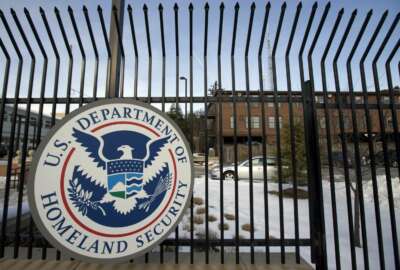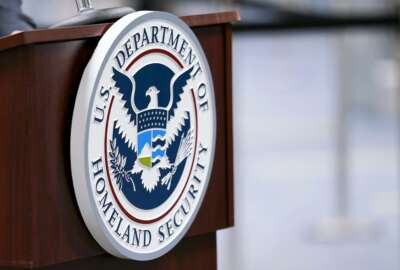Homeland Security seeks ideas from the public for greater community disaster resilience
Homeland Security's Science and Technology Directorate is in the midst of series of prize competitions. It's asking people to come up with great ideas for helpi...
Best listening experience is on Chrome, Firefox or Safari. Subscribe to Federal Drive’s daily audio interviews on Apple Podcasts or PodcastOne.
Homeland Security’s Science and Technology Directorate is in the midst of series of prize competitions. It’s asking people to come up with great ideas for helping communities deal with hazards thought to relate to climate change. The theme is resilience. Joining Federal Drive with Tom Temin from the Directorate with details, the senior science advisor for resilience, David Alexander. And the prize challenge program manager, Kathleen Kenyon.
Interview transcript:
Tom Temin: The Senior Science Advisor for Resilience, David Alexander. Mr. Alexander, good to have you on.
David Alexander: Thank you, Tom. Glad to be here.
Tom Temin: And the Prize Challenge Program Manager Kathleen Kenyon. Ms. Kenyon, good to have you on.
Kathleen Kenyon: Thank you, Tom. Good to be here too.
Tom Temin: All right. So David, we’ll start with you. What is the problem? Describe what it is the Directorate is trying to get at here.
David Alexander: Well Tom, as you introduced, DHS just announced that it’s starting a series of prize competitions on strengthening the nation’s resilience to climate change and cascading impacts from disasters. Our first prize competition is really focused on finding climate friendly solutions to extreme heat that can provide access to cooling for people in public and residential areas. We call this the cooling solutions challenge. And we’re looking to seek novel ways to protect those at risk of heat related illness or death. Now, we’ve identified four key use cases in this challenge. The first is first responders and critical infrastructure service and those working outdoors. The second is individual households without a need for retrofit, meaning having to do remodeling on their homes. The third is group quarters, such as shelters or temporary shelters. And the fourth is outdoor use to support vulnerable populations, and to better serve the homeless or other displaced individuals.
Tom Temin: And so when you say climate friendly solutions, that means you just can’t throw out 10 million air conditioners out. They’re all running on AC power and using Freon for example.
David Alexander: Right. So we understand that there’s existing solutions in the marketplace. However, what this challenge identifies is that, during these types of events, particularly cascading events, such as hurricanes, you see a loss of power. So even though folks may have traditional cooling solutions, like AC, during these events and loss of power, they lose access to those conventional solutions. And so we’re looking at new innovations that not only can provide new market products, but also could provide resiliency, meaning giving people alternative means for cooling, in addition to the solutions they may already have in place at affordable price point. And that don’t increase the carbon emissions or other toxic emissions and are low energy solutions.
Tom Temin: Got it. And this is something then that is a fairly widespread problem. I mean, it would seem like every summer, given the wildfires and what happens in some of the cities, this is something that’s common, the need here.
David Alexander: Yeah. So what is not necessarily well understood by the public is that while we put a lot of attention, as you mentioned on hurricanes and wildfire, extreme heat seriously threatens communities across the country, and in fact, is the nation’s leading cause of weather related deaths. Partly, it’s due to the loss of electricity that I just mentioned, that commonly occurs during disasters, as well as the effects of unseasonable hot temperatures. And the vulnerability of people, particularly those working outdoors or those that just don’t have access to cooling that I just mentioned, and them experiencing heat related illness. So having access to new technology, innovation helps us to address that large national concern.
Tom Temin: All right. And with respect to the Science and Technology Directorate, how come FEMA is not doing this or, how does this come into the Directorate as a place to conduct this?
David Alexander: Great question. Fact is that DHS S&T, we serve as all of our operating components and their core missions. And so FEMA is actually a partner with DHS S&T on this, as well as the Office of the Secretary of Homeland Security. So this is not S&T just striking out on its own. This is S&T collaborating with our key agencies, as well as working with a support organizations to serve as needs that not only will benefit our federal agencies and resources, but also support our state local community, as well as key partners like public utilities and other infrastructure operators.
Tom Temin: Alright, David Alexander is the Senior Science Advisor for resilience in the Homeland Security Science and Technology Directorate. And now we turn to Kathleen Kenyon. She’s the Prize Challenge Program Manager. And tell us how this all works. What are the timelines here and how do people participate?
Kathleen Kenyon: Thanks, Tom. First off prize competitions are a way that we can inspire those in the public, citizens to really give us novel innovative solutions. Prize challenges give us a lot of flexibility, and we really do seek to spark some creativity and also find some great ideas and solutions. And even send a demand signal to those in the private sector that these are the types of things when we do a prize competition, these are the types of things we’re looking for. So this prize competition is really easy to submit your entry, we are just looking for a great solution, describe it, tell us what it can do. Tell us how it meets the challenge description. And we’re asking for either a short description white paper or a video submission. So it leaves a lot of latitude for those who are submitting an entry into the prize competition. Let me turn to the prize winning. So the prize winnings are for first prize, it’s $50,000. For a second prize, it’s $20,000. And then we have some nominal prizes for like third and runner up prizes. It’s super easy to submit, we have two stages to the prize, the first deadline is December 7, which we give people lots of time to think about what they want to submit and how they want to craft their submission. And then we’re have a stage one, judging for their contests, and award after stage one up to 15 entries, $5,000. And then those will automatically advance to stage two. And that is a little bit more of a judging based upon the criteria that David described. And then we’re looking at a roughly a March timeframe to announce the winners, and those winners will be winning those $50,000, as well as the 20,000.
Tom Temin: All right. And do you anticipate mostly nonprofits, local community type groups, academics applying for these or maybe some small businesses?
Kathleen Kenyon: I think all walks of life definitely can apply. We are definitely looking at academia, private sector, and those citizen inventors to have a great idea, and are really innovative and have some great solutions. We’ve seen in the past that happen with prize challenges. This is our 10th one. And in the past with a prize competition we did with US Coast Guard, the prize winner actually was a recreational scuba diver that saw the prize challenge. He loved it, he had a great idea. He used some commercial off the shelf technology and created a solution for the Coast Guard that’s working today. So those are the types of individuals who really want inspire. So it’s whether if you’re a student, or you’re a tinkerer, you’d like to be an innovator, or you’re in a small business and you really want to apply for the challenge, please apply. We’re looking to see your solution.
Tom Temin: And then there will be a mechanism for the solutions to become products if that’s what’s indicated.
Kathleen Kenyon: Yeah, so one of the great things about price challenges is that we’re able to work with the finalists or the winners after the prize challenge, the mentoring capacity. We have great networks to accelerators and incubators and other partners that can help with mentoring and experts. And we also have great ways to connect them with manufacturing partners that might be able to help them bring their technology or their solution to the commercial marketplace.
Tom Temin: Kathleen Kenyon is Prize Competition Program manager at the Homeland Security Science and Technology Directorate. Thanks so much for being with me.
Kathleen Kenyon: Thank you, Tom.
Tom Temin: And earlier we heard from David Alexander, the senior science advisor for resilience. David, good to have you.
David Alexander: Thank you as well.
Copyright © 2024 Federal News Network. All rights reserved. This website is not intended for users located within the European Economic Area.
Tom Temin is host of the Federal Drive and has been providing insight on federal technology and management issues for more than 30 years.
Follow @tteminWFED






